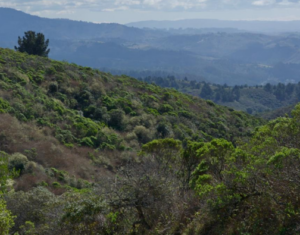Targeted Grazing
View article.
Data-driven decision support can help guide sustainable grazing management by providing an accurate estimate of grazing capacity, in coproduction with managers. Here, we described the development of a decision support model to estimate grazing capacity and illustrated its application on two sites in the western United States. For the Montgomery PassWild Horse Territory in California and Nevada, the upper limit estimated in the capacity assessment was 398 horses and the current population was 654 horses. For the Eagle Creek watershed of the Apache-Sitgreaves National Forest of eastern Arizona, the lower end of capacity was estimated at 1560 cattle annually, compared to the current average of 1090 cattle annually. In addition to being spatio-temporally comprehensive, the model provides a repeatable, cost-effective, and transparent process for establishing and adjusting capacity estimates and associated grazing plans that are supported by scientific information, in order to support livestock numbers at levels that are sustainable over time, including levels that are below average forage production during drought conditions. This modeling process acts as a decision support tool because it enables different assumptions to be used and explored to accommodate multiple viewpoints during the planning process.
Webinar registration.
Title: How LANDFIRE EVT contributes to the estimation of forage and seasonal range in Idaho: A perspective through time 2003-2023
Speaker: Scott Bergen, Senior Wildlife Research Biologist, Idaho Department of Fish and Game
Summary: Idaho Dept of Fish and Game uses LANDFIRE extant vegetation type databases 2001-2023 to estimate seasonal range analyses of Idaho’s big game species. Using mule deer as a focal species, IDFG has developed multi-temporal analyses that use GPS data that has been collected from deployed location collars through time (2003- present). One of the most influential factors in determining mule deer summer range is the quality of forage where IDFG reclassifies EVT vegetation data into forage type data. This data, along with several other graphic data are ‘mined’ using machine-learning algorithms to estimate both winter and summer range conditions for a seasonally migratory species and their conservation management. We will discuss how LANDFIRE data is used, some of the problems and inconsistencies found with LANDFIRE (2001-2023), and how LANDFIRE is an invaluable resource for the management of this iconic western species.
Access the resources.
Virtual fence (VF) has the potential to revolutionize grazing systems by allowing dynamic control of livestock distribution and duration. The system uses invisible barriers, established by Global Positioning System (GPS) coordinates, to influence livestock movement with a combination of auditory and electrical cues without a physical fence. However, it can be also be complicated and expensive.
This digital guide was created to empowers ranchers and land managers to effectively evaluate and use VF for improved rangeland management. Explore the foundations of VF factsheets, watch the videos, access geospatial resources, and explore handouts from workshops and webinars to better understand a VF system.
View article.
We examined management effects on bee abundance and other insect pollinators on grazed and idle sagebrush rangelands in central Montana, USA. From 2016 to 2018, we sampled pollinators on lands enrolled in rest-rotation grazing, unenrolled grazing lands, and geographically separate idle lands without grazing for over a decade. Bare ground covered twice as much area (15% vs. 7) with half the litter (12% vs. 24) on grazed than idle regardless of enrollment. Bee pollinators were 2–3 times more prevalent in grazed than idle in 2016–2017. In 2018, bees were similar among grazed and idled during an unseasonably wet and cool summer that depressed pollinator catches; captures of secondary pollinators was similar among treatments 2 of 3 study years. Ground-nesting bees (94.6% of total bee abundance) were driven by periodic grazing that maintained bare ground and kept litter accumulations in check. In contrast, idle provided fewer nesting opportunities for bees that were mostly solitary, ground-nesting genera requiring unvegetated spaces for reproduction. Managed lands supported higher bee abundance that evolved with bison grazing on the eastern edge of the sagebrush ecosystem. Our findings suggest that periodic disturbance may enhance pollinator habitat, and that rangelands may benefit from periodic grazing by livestock.
View article.
The invasive annual grass, medusahead, infests rangelands throughout the West, from the Columbia Plateau to the California Annual Grasslands and the Great Basin. Dominating secondary succession in the sagebrush steppe, medusahead can degrade the habitat of threatened species such as the greater sage-grouse. This research explores the potential of dormant season grazing as an applied management strategy to reduce the negative impacts of medusahead while promoting recovery of perennial vegetation at the landscape scale. In particular, it assessed grazing with four treatments from 2018 to 2020: traditional grazing (May–October), dormant season grazing (October–February), traditional + dormant season grazing (May–February), and no grazing. After 2 yr of grazing treatments, biomass, density, cover, and fuel continuity did not differ between treatments (P > 0.05). However, biomass measurements were significantly different between years, which is likely due to greater than normal precipitation in 2019 and 2020. Between 2018 and 2019, annual grass biomass increased by 81% (666–1 212 kg ha−1) and perennial grass biomass increased by 165% (118–313 kg ha−1). Litter biomass decreased by approximately 15% in every year since 2018 (2 374, 2 012, and 1 678 kg ha−1 in 2018–2020). There were not significant differences in cover or density of annual and perennial grasses between treatments and years. Our results indicate that 2 yr may not be adequate time for dormant season grazing treatments to be effective in reducing the abundance of medusahead and that after 2 yr of treatments, dormant season grazing does not have a detrimental effect on perennial vegetation.
View article.
Targeted grazing in the Great Basin has been used to reduce cheatgrass fuel loads and enhance wildfire control. In this project, we evaluate the economic impact of targeted grazing on cow-calf ranches across southeast Oregon, northeast Nevada, and southwest Idaho when practices such as fencing, water hauling, and herding are necessary for producers to accomplish desired grazing outcomes. Large and small representative ranch models were developed for major land resource areas 23, 24, and 25 where applicable. Typical targeted grazing costs and practices were obtained from producer and agency focus groups in each state and introduced into ranch economic models. Targeted grazing periods begin 1 mo before typical Bureau of Land Management turnout in the spring and again in the fall after typical public land grazing ends. In each year, targeted grazing would occur when the previous growing season (September to March and April to August) had more than 25% of median precipitation based on PRISM historical data. Hence, targeted grazing could occur in the spring, fall, or both depending on precipitation. In both seasons, targeted grazing continues until the desired animal unit months of forage are removed. One hundred precipitation data sets were randomly generated using Excel to mimic the actual number of drought years in the spring and fall. The model is a 40-yr recursive linear programming model using 100 cattle price sets and the 100 precipitation sets. Results are averaged over 10 000 model runs and compared with scenarios with no targeted grazing and targeted grazing based on the actual precipitation data set. Results show changes in cattle herd size, hay sales, and the economic impacts to the public land ranch operation for two ranch sizes in each of the three major land resource areas by state.
Background: Geo-fencing provides some unique advantages over conventional fencing approaches. This is especially true when we consider the devastation to fencing, and other rangeland infrastructure, caused by wildfires. Geo-fencing is increasingly used with public land grazing leases, but the cost-effectiveness of geo-fencing and common challenges are not well understood. Issues such as cost-effectiveness, environmental concerns, animal welfare, and system efficacy remain unclear.
In this Summit, we provide a forum for producers, managers, and USDA Forest Service agency leadership to share their insights, successes, and failures while answering questions in the process. Geo-fencing may have a significant role to play in the future of public land management. In this Summit, we provide a backdrop against which we can come to some common understanding of what the technology affords including the considerations needed prior to implementation.
Summit Scope & Components: The objective is to enable Summit participants to learn from the real-world experience provided by managers, agency leaders, and producers. In this Summit, we discuss geo-fencing through a series of coupled 20-minute presentations followed by a 30-minute live question-and-answer session. In this manner, we aim to engage participants from a wide range of experiences and disciplines.
Deliverables & Benefits:
- The meeting itself. It provides an important means of information exchange where we can all learn from each other.
- Recorded 20-minute presentations that can be revisited remotely anytime.
- Identification of new partnerships between producers, managers, and researchers to foster more effective land management strategies to be developed across more regions.
Visit conference website.
This year’s annual conference will be in Boise, ID.
Webinar recording.
This presentation discusses a pilot project in partnership with the BC Cattlemen’s Association and the Province of British Columbia that uses cattle grazing to reduce wildfire risk in wildland-urban interface areas. Amanda Miller, of Palouse Rangeland Consulting is engaged as the liaison, coordinator, and researcher for the development, pilot, and testing of livestock use models for fine fuel management.






